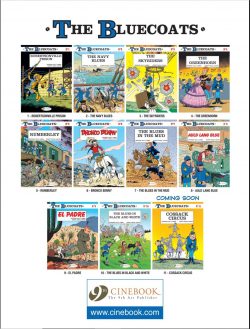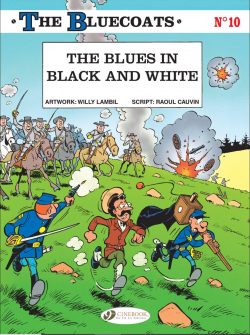

By Willy Lambil & Raoul Cauvin, translated by Jerome Saincantin (Cinebook)
ISBN: 978-1-84918-341-3 (Album PB)
Win’s Christmas Gift Recommendation: Read Some Pictures: It’ll Last Longer… 8/10
The myths and legends of the cinematic American West have fascinated Europeans virtually since the actual days of stagecoaches and gunslingers. Hergé and Moebius were passionate devotees and the wealth of stand-out Continental comics series ranges from Italy’s Tex Willer to such Franco-Belgian classics as Blueberry and tangential all-ages classics such as Yakari. Even colonial dramas such as Pioneers of the New World and Milo Manara & Hugo Pratt’s Indian Summer fit the broad-brimmed bill.
As devised by Louis “Salvé†Salvérius & Raoul Cauvin – who scripted the first 64 best-selling volumes until his retirement in 2020 – Les Tuniques Bleues (The Bluecoats) debuted at the end of the 1960s, specifically created to replace Lucky Luke when the laconic maverick defected from weekly anthology Le Journal de Spirou to rival publication Pilote.
The substitute swiftly became one of the most popular bande dessinée series in Europe.
Salvé was a cartoonist of the Gallic big-foot/big-nose humour school, and when he died suddenly in 1972, his replacement, Willy “Lambil†Lambillotte slowly introduced a more realistic – but still overtly comedic – illustrative tone and manner. Lambil is Belgian, born in 1936 and, after studying Fine Art in college, joined publishing giant Dupuis in 1952 as a letterer.
Born in 1938, scripter Cauvin is also Belgian and – before entering Dupuis’ animation department in 1960 – studied Lithography. He soon discovered his true calling – comedy writing – and began a glittering and prolific career at Spirou. In addition to Bluecoats he scripted dozens of long-running, award winning series including Cédric, Les Femmes en Blanc and Agent 212: more than 240 separate albums. The Bluecoats alone has sold more than 15 million copies of its 65 (and counting) album sequence.
Our sorry, long-suffering protagonists are Sergeant Cornelius Chesterfield and Corporal Blutch; a pair of worthy fools in the manner of Laurel & Hardy: hapless, ill-starred US cavalrymen posted to the wild frontier and various key points of fabled America during the War Between the States.
The original format featured single-page gags set around an Indian-plagued Wild West fort, but from the second volume – Du Nord au Sud – the sad-sack soldiers were situated back East, fighting in the American Civil War. All subsequent adventures – despite ranging far beyond the traditional environs of America and taking in a lot of genuine and thoroughly researched history – are set within the timeframe of the Secession conflict.
Blutch is your run-of-the-mill, whinging little-man-in-the street: work-shy, mouthy, devious and especially critical of the army and its inept commanders. Ducking, diving, even deserting whenever he can, he’s you or me – except sometimes he’s quite smart and heroic if no easier option is available.
Chesterfield is a big, burly professional fighting man; a career soldier who has passionately bought into all the patriotism and esprit-de-corps of the Military. He is brave, never shirks his duty and wants to be a medal-wearing hero. He also loves his cynical little troll of a pal. They quarrel like a married couple, fight like brothers and simply cannot agree on the point and purpose of the horrendous war they are trapped in…
The Blues in Black and White was the 10th translated Cinebook album (chronologically the 11th European volume) and as Les Tuniques Bleues: Des bleus en noir et blanc was first seen on the continent in 1975, serialised in Le Journal de Spirou #1965 to #1975 before becoming an album collection two years later.
It opens with another spectacular yet pointless battle, with Blutch in fine whining form after a string of horrific near-death experiences. His mood is further tested when he finds a civilian prowling about, pointing a weird box at casualties and other scenes of horror…
The oblivious, self-absorbed stranger is Matthew Brady, who has been sent by President Lincoln to record the war through the strange new medium of photography. After becoming an unwilling subject and accidental laughing stock, Chesterfield is deeply suspicious and, soon after, resentfully resistant as his vain superiors and battle-weary comrades embrace the technological marvel. Before he can react, he and Blutch are appointed bodyguards and dogsbodies: compelled to escort the oblivious, practically-suicidal snapper anywhere and everywhere he wants…
Soon, however, the surly sergeant has all the combat his warrior’s heart can cope with – and even the long-desired prospect of a gong – whilst the sly, shirking corporal has found a way to utterly avoid battle by becoming the photographer’s assistant. He even dresses like a civilian now!
As the daily carnage continues, Chesterfield becomes increasingly irked at the effect of the picture maker. Almost everyone wants to be captured for posterity, to the detriment of actual fighting. While Brady is gone, Blutch “immortalises†everyone, and the sergeant teeters on the brink of madness. He even takes charge of charging whilst his officers are too busy preening and primping for their next heroic pose…
The lethal status quo returns with a bump when the President shows up to decorate Chesterfield. Brady is with him and ready to take his own shots again, meaning Blutch can get back to fighting – just as the Confederate forces rally to retake all the ground they’ve lost while the Sarge was secretly in command…
Things go from bad to worst, as the Rebel response swiftly overwhelms the Union forces. When Lincoln and Brady are almost captured, Blutch and Chesterfield show just what they’re made of… and pay a heavy price…
A shade darker than usual, this wry treatise on fame and pride is a hugely amusing poke at the glory boys of history, deftly delivering an anti-war saga cleverly targeting younger, less world-weary audiences. Historically authentic, and always in good taste despite an uncompromising portrayal of violence, the attitudes expressed by our down-to-earth pair never make battle anything but arrant folly. These are comedic tales whose very humour makes the occasional moments of shocking verity doubly powerful and hard-hitting.
Funny, thrilling, beautifully realised and eminently readable, Bluecoats is the kind of war-story and Western that appeals to the best, not worst, of the human spirit.
© Dupuis 1977 by Lambil & Cauvin. All rights reserved. English translation © 2017 Cinebook Ltd.
